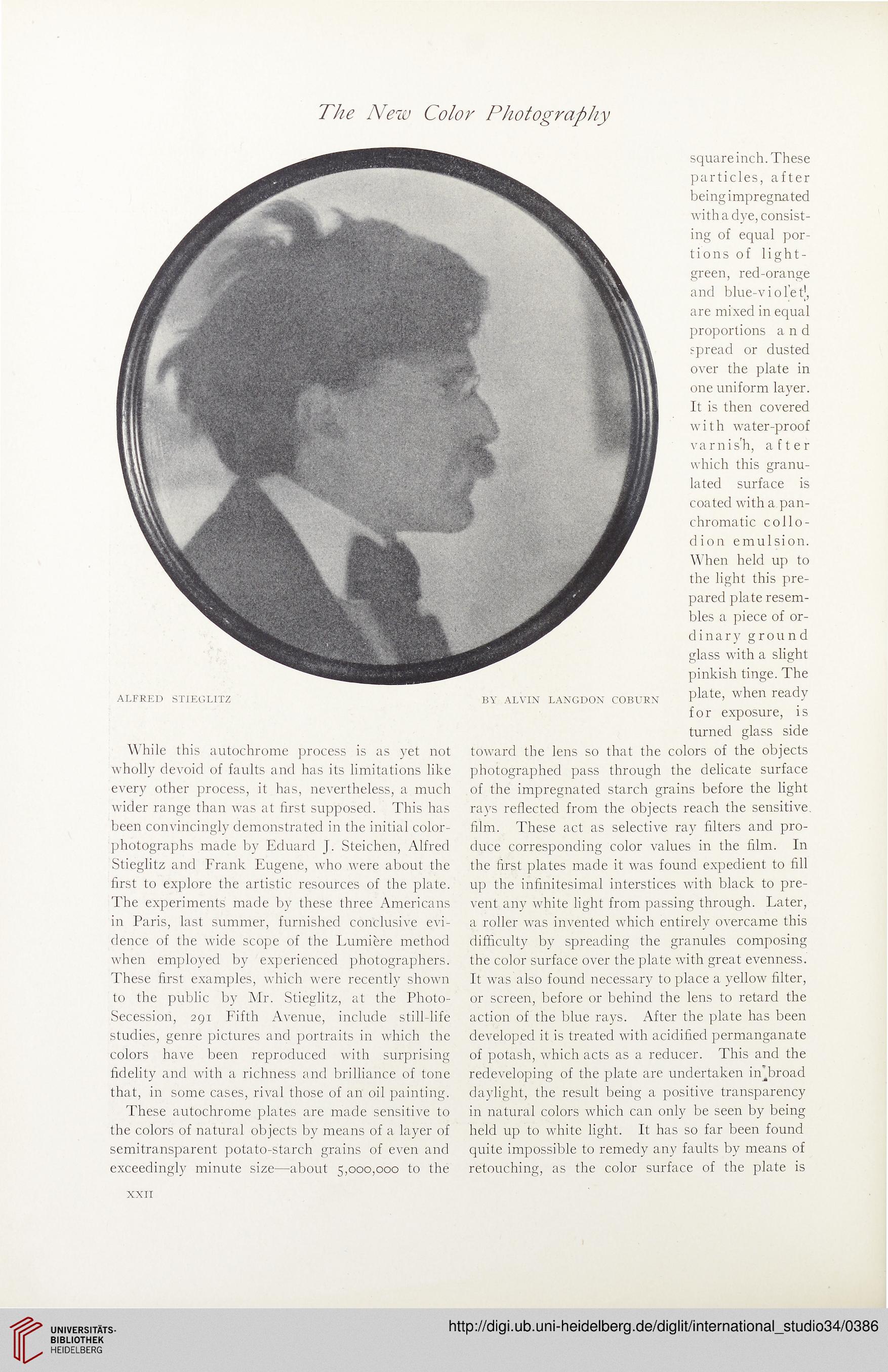The New Color Photography
ALFRED STIEGLITZ
While this autochrome process is as yet not
wholly devoid of faults and has its limitations like
every other process, it has, nevertheless, a much
wider range than was at first supposed. This has
been convincingly demonstrated in the initial color-
photographs made by Eduard J. Steichen, Alfred
Stieglitz and Frank Eugene, who were about the
first to explore the artistic resources of the plate.
The experiments made by these three Americans
in Paris, last summer, furnished conclusive evi-
dence of the wide scope of the Lumiere method
when employed by experienced photographers.
These first examples, which were recently shown
to the public by Mr. Stieglitz, at the Photo-
Secession, 291 Fifth Avenue, include still-life
studies, genre pictures and portraits in which the
colors have been reproduced with surprising
fidelity and with a richness and brilliance of tone
that, in some cases, rival those of an oil painting.
These autochrome plates are made sensitive to
the colors of natural objects by means of a layer of
semitransparent potato-starch grains of even and
exceedingly minute size—about 5,000,000 to the
square inch. These
particles, after
being impregnated
with a dye, consist-
ing of equal por-
tions of light-
green, red-orange
and blue-viol'etj,
are mixed in equal
proportions and
spread or dusted
over the plate in
one uniform layer.
It is then covered
with water-proof
varnisfi, after
which this granu-
lated surface is
coated with a pan-
chromatic collo-
dion emulsion.
When held up to
the light this pre-
pared plate resem-
bles a piece of or-
d i n a r y ground
glass with a slight
pinkish tinge. The
plate, when ready
for exposure, is
turned glass side
toward the lens so that the colors of the objects
photographed pass through the delicate surface
of the impregnated starch grains before the light
rays reflected from the objects reach the sensitive,
film. These act as selective ray filters and pro-
duce corresponding color values in the film. In
the first plates made it was found expedient to fill
up the infinitesimal interstices with black to pre-
vent any white light from passing through. Later,
a roller was invented which entirely overcame this
difficulty by spreading the granules composing
the color surface over the plate with great evenness.
It was also found necessary to place a yellow filter,
or screen, before or behind the lens to retard the
action of the blue rays. After the plate has been
developed it is treated with acidified permanganate
of potash, which acts as a reducer. This and the
redeveloping of the plate are undertaken injbroad
daylight, the result being a positive transparency
in natural colors which can only be seen by being
held up to white light. It has so far been found
quite impossible to remedy any faults by means of
retouching, as the color surface of the plate is
BY ALVIN LANGDON COBURN
XXII
ALFRED STIEGLITZ
While this autochrome process is as yet not
wholly devoid of faults and has its limitations like
every other process, it has, nevertheless, a much
wider range than was at first supposed. This has
been convincingly demonstrated in the initial color-
photographs made by Eduard J. Steichen, Alfred
Stieglitz and Frank Eugene, who were about the
first to explore the artistic resources of the plate.
The experiments made by these three Americans
in Paris, last summer, furnished conclusive evi-
dence of the wide scope of the Lumiere method
when employed by experienced photographers.
These first examples, which were recently shown
to the public by Mr. Stieglitz, at the Photo-
Secession, 291 Fifth Avenue, include still-life
studies, genre pictures and portraits in which the
colors have been reproduced with surprising
fidelity and with a richness and brilliance of tone
that, in some cases, rival those of an oil painting.
These autochrome plates are made sensitive to
the colors of natural objects by means of a layer of
semitransparent potato-starch grains of even and
exceedingly minute size—about 5,000,000 to the
square inch. These
particles, after
being impregnated
with a dye, consist-
ing of equal por-
tions of light-
green, red-orange
and blue-viol'etj,
are mixed in equal
proportions and
spread or dusted
over the plate in
one uniform layer.
It is then covered
with water-proof
varnisfi, after
which this granu-
lated surface is
coated with a pan-
chromatic collo-
dion emulsion.
When held up to
the light this pre-
pared plate resem-
bles a piece of or-
d i n a r y ground
glass with a slight
pinkish tinge. The
plate, when ready
for exposure, is
turned glass side
toward the lens so that the colors of the objects
photographed pass through the delicate surface
of the impregnated starch grains before the light
rays reflected from the objects reach the sensitive,
film. These act as selective ray filters and pro-
duce corresponding color values in the film. In
the first plates made it was found expedient to fill
up the infinitesimal interstices with black to pre-
vent any white light from passing through. Later,
a roller was invented which entirely overcame this
difficulty by spreading the granules composing
the color surface over the plate with great evenness.
It was also found necessary to place a yellow filter,
or screen, before or behind the lens to retard the
action of the blue rays. After the plate has been
developed it is treated with acidified permanganate
of potash, which acts as a reducer. This and the
redeveloping of the plate are undertaken injbroad
daylight, the result being a positive transparency
in natural colors which can only be seen by being
held up to white light. It has so far been found
quite impossible to remedy any faults by means of
retouching, as the color surface of the plate is
BY ALVIN LANGDON COBURN
XXII




